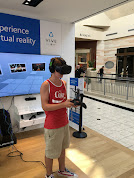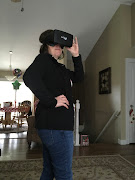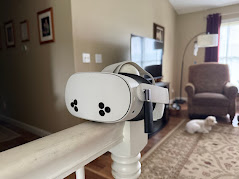 Like many people, I’d like to have an Apple Vision Pro. But I simply can’t justify the expense. Instead, I purchased the Meta Quest 3S shortly after it was announced. To be clear, I am not a gamer. Despite growing up during the era of arcade games and early gaming consoles, I have never really enjoyed playing them. In 2016, the Galleria Mall in St Louis opened a Microsoft Store and they were doing demonstrations of the new VR headsets. Our son was an early adopter and purchased a VR headset a year or two later as several manufacturers were starting to release their wired headsets onto the market. Although these early versions were interesting, I didn’t see much of a use case for myself.
Like many people, I’d like to have an Apple Vision Pro. But I simply can’t justify the expense. Instead, I purchased the Meta Quest 3S shortly after it was announced. To be clear, I am not a gamer. Despite growing up during the era of arcade games and early gaming consoles, I have never really enjoyed playing them. In 2016, the Galleria Mall in St Louis opened a Microsoft Store and they were doing demonstrations of the new VR headsets. Our son was an early adopter and purchased a VR headset a year or two later as several manufacturers were starting to release their wired headsets onto the market. Although these early versions were interesting, I didn’t see much of a use case for myself.
The seeds were planted, though. When my wife and I were thinking about purchasing an RV (this was a couple years prior to Covid when just about everyone decided to purchase RVs), a legitimate use case presented. Google had released its Google Cardboard project and I purchased a contraption that allowed you to use your phone as the display for VR videos. Using this, we were able to take virtual tours of different RV models located a good distance from our home. I had to admit, this was pretty cool.
Now, however, I find the technology much more useful. I have been using it while on my exercise bike to watch videos of people cycling in various locations. It helps alleviate some of the monotony of indoor cycling. I also like to watch motorcycling videos through the headset. Some games have even been making their way onto my Meta Quest, particularly ones that help me move about more like Match Point Tennis, Eleven Pickleball, Eleven Table Tennis, Golf+, Premium Bowling, and Guided Tai Chi.
The most recent app I have installed is the Meta Quest HDMI Link app. I recently learned that this app allows me to use a $15 USB-C capture card I had already purchased from our local Micro Center to connect my Mac to the Quest and use it as a virtual display. I have seen mixed reviews for apps that allow you to do something similar wirelessly, but I like the simplicity of just plugging this in and it working as one large virtual display. I’m not really interested in having multiple smaller displays since the resolution isn’t high enough for that to be useful for me. I also like seeing my surroundings and the ability to see the keyboard and even papers I might be using. To keep the weight of the capture card and HDMI cable from pulling on the Quest’s USB port, I am using a 90° USB-C adapter. I like that I can use this with my laptop, my wife’s laptop (our personal finance software is on hers), and even my iPad Pro. I could use it on the Lenovo laptop I use for some part-time work I perform for our church, but since that runs Windows 11 (needed for a program we use that is Windows only), its built-in virtual display works very well with Quest. This feature was recently updated and now allows the user to have an ultra-wide display, very similar to Apple’s Vision Pro update. Of course, the resolution on the Quest is not as high as the Vision Pro, so we’re not exactly comparing apples-to-apples. But at 1/10th the cost, that’s a trade-off I am able to live with. If you are curious about VR but not willing to invest at the price of the Apple Vision Pro, I recommend looking at the Meta Quest 3 or the Meta Quest 3S. You lose display resolution, but you can get similar functionality and a much more robust offering of apps to use with the device at a much more affordable price.

